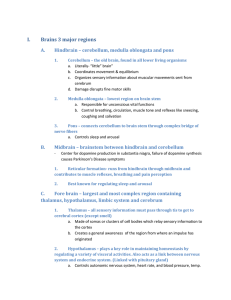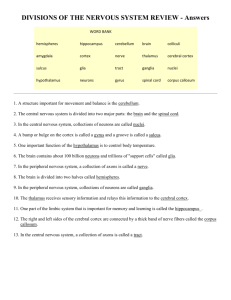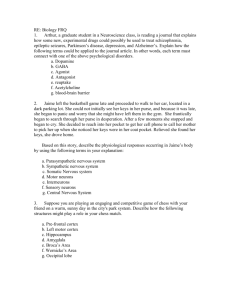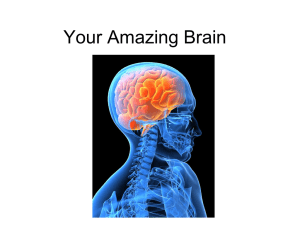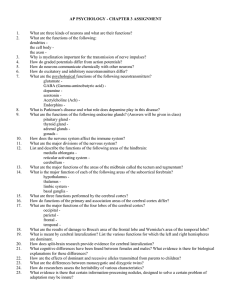Spring 2006
advertisement
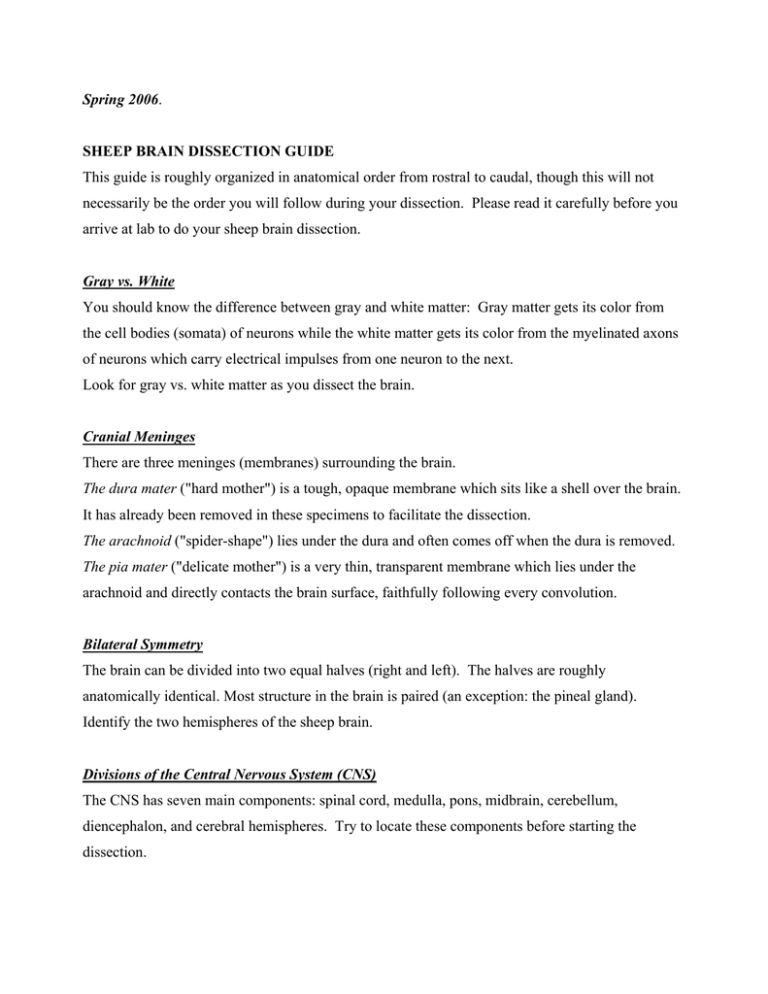
Spring 2006. SHEEP BRAIN DISSECTION GUIDE This guide is roughly organized in anatomical order from rostral to caudal, though this will not necessarily be the order you will follow during your dissection. Please read it carefully before you arrive at lab to do your sheep brain dissection. Gray vs. White You should know the difference between gray and white matter: Gray matter gets its color from the cell bodies (somata) of neurons while the white matter gets its color from the myelinated axons of neurons which carry electrical impulses from one neuron to the next. Look for gray vs. white matter as you dissect the brain. Cranial Meninges There are three meninges (membranes) surrounding the brain. The dura mater ("hard mother") is a tough, opaque membrane which sits like a shell over the brain. It has already been removed in these specimens to facilitate the dissection. The arachnoid ("spider-shape") lies under the dura and often comes off when the dura is removed. The pia mater ("delicate mother") is a very thin, transparent membrane which lies under the arachnoid and directly contacts the brain surface, faithfully following every convolution. Bilateral Symmetry The brain can be divided into two equal halves (right and left). The halves are roughly anatomically identical. Most structure in the brain is paired (an exception: the pineal gland). Identify the two hemispheres of the sheep brain. Divisions of the Central Nervous System (CNS) The CNS has seven main components: spinal cord, medulla, pons, midbrain, cerebellum, diencephalon, and cerebral hemispheres. Try to locate these components before starting the dissection. Cerebral Cortex The cerebral cortex is the thin (~4 mm thick in humans) wrinkled gray matter that covers the outer part of the cerebral hemispheres; the word "cortex" is derived from the Greek word for "bark". The neocortex is the most recently evolved part of the cerebral cortex (shows up first as a distinct structure in mammals). The nomenclature here is a bit confusing because the cerebral cortex is actually composed of new (neo-, 6 layers) and old (arche-, 3 layers) cortices, but neocortex has become synonymous with cerebral cortex. The size of the mammalian skull is limited, and the expansion of the neocortex which occurred during evolution had to happen without a huge increase in surface area. This may be why the mammalian brain became convoluted. When you look at the sheep brain, you will see the hills (gyri) and valleys (sulci) which cover the cerebral surface and are the result of this increase in brain area. More than 2/3 of the cerebral cortex in the human brain is buried in the sulci! Note: In the human brain, certain sulci and gyri are reliable landmarks for divisions between the lobes and between adjacent areas of the cerebral cortex which perform different functions; however, in sheep brains, the landmarks and the divisions between functional areas are not as obvious. The cerebral cortex is composed of four lobes (frontal, parietal, temporal and occipital) which are named after the cranial bones which overlie each lobe. To put it very simply, the functions of each lobe are as follows: Frontal -- motor control, short-term memory, planning, strategy formulation, problem solving, personality, language; Parietal -- spatial processing, attention, somatosensory processing, some language Temporal -- visual feature recognition, audition, memory Occipital -- vision Identify the frontal, parietal, temporal, and occipital lobes. Peel off some pia mater with your forceps to see how thin it is. Identify sulci and gyri. Identify the cerebral fissure. Stick your thumbs down into the cerebral fissure and gently separate the cerebral hemispheres. The bright white band you see connecting the hemispheres is the corpus callosum. Carefully cut through the caudal-most part of the cerebral fissure, gently pulling apart the hemispheres and removing pia as necessary. Gently pull back the cerebellum until you can see the midbrain. You should see the pineal gland, and the superior and inferior colliculi. The Visual System Retinothalamic Projections and Lateral Geniculate Nucleus (LGN) Light enters the eye through the lens and strikes the retina at the back of the eye. Photoreceptors in the retina transmit light information to other retinal neurons which process the information and send the output to the rest of the brain via the optic nerve which projects from the back of the eyeball. The right and left optic nerves cross at the optic chiasm, forming a distinctive "X" on the ventral surface of the brain. After the nerves cross, they each contain information from both eyes; after this point, they are called the optic tracts. The lateral geniculate nucleus (LGN) of the thalamus receives retinal information. Retinal information is also sent to the superior colliculus, a midbrain structure which directs eye movements. After processing visual information, LGN neurons send their output to primary visual cortex via a fiber tract called the optic radiation. Primary Visual Cortex (V1) V1 is located in occipital cortex and, like all neocortex, contains six layers. Input from the LGN is sent to layer 4 (the typical input layer of all sensory neocortex). A primary cortical area is always the first to receive sensory information. The information is processed and then sent to higher cortical areas (e.g., secondary, tertiary cortex) for additional processing. Cranial Nerves There are twelve cranial nerves. Each cranial nerve is either sensory, motor or mixed. NI = olfactory nerve; sensory; transmits olfactory information NII = optic nerve; sensory; transmits visual information NIII = oculomotor nerve; motor; controls eye movements (via rectus muscles) NIV = trochlear nerve; motor; controls eye movements (via superior oblique muscle) NV = trigeminal nerve; mixed; many functions including transmission of sensory input from skin and muscles of head and control of mastication NVI = abducens nerve; motor; controls eye movements (via lateral rectus muscle) NVII = facial nerve; mixed; many functions including transmission of sensory input from the outer ear and taste buds, and control of facial expression and glands NVIII = vestibulocochlear nerve; sensory; transmits auditory and vestibular information NIX = glossopharyngeal nerve; mixed; many functions including transmission of sensory input from the outer ear and taste buds, and control of the pharynx NX = vagus nerve; mixed; many functions including transmission of sensory input and control of thoracic and abdominal viscera and the larynx NXI = spinal accessory nerve; motor; control of upper thoracic muscles NXII = hypoglossal nerve; motor; controls tongue Turn the brain over so its ventral surface is visible. Identify the optic chiasm, optic nerves (rostral to the chiasm; may only be stumps because they are cut to remove the brain from the skull) and optic tracts (caudal to the chiasm; you can follow them as they continue back caudally and laterally toward each LGN). Identify the LGNs, which lie at the posterolateral edges of the thalamus. All cranial nerves, with the exception of the trochlear nerve, emanate from the ventral side of the brain. The trochlear nerve emanates from the dorsal side. Try to identify as many as you can using Figure 2 as a guide. Now place the brain ventral side down on the dissecting tray. Align the scalpel blade so that it is directly over the cerebral fissure (i.e., midsagittal) and push it straight down through the whole brain. You now have two equal brain halves (think back to the bilateral symmetry discussion). Ventricular System In mammals, the ventricular system is comprised of a pair of lateral ventricles, the third ventricle, and the fourth ventricle. The lateral ventricles are the most extensive, having anterior, temporal, and posterior horns. They are separated by a paired membrane, the septum pellucidum, and are connected to the third ventricle via the narrow interventricular foramen. The third ventricle divides the diencephalon and connects with the fourth ventricle via the cerebral aqueduct. The fourth ventricle lies between the cerebellum and the brainstem and merges with the spinal canal. The ventricular system allows cerebrospinal fluid (CSF) to circulate throughout the brain. CSF is provides the medium of exchange for nutrients and wastes, and it provides hydrodynamic support for the brain. CSF is made by the choroid plexus, a convoluted membrane which lines the ventricles. Basal Ganglia The basal ganglia are a group of nuclei that play an important role in high-order, cognitive aspects of motor control, such as planning and execution of complex movements. B by virtue of their connectivity to frontal lobe areas, they may also play an important role in non-motor cognitive functions. A nucleus of the midbrain called the substantia nigra pars compacta is an important source of dopaminergic projections to the caudate nucleus and the putamen (together, called the striatum). Loss of dopaminergic cells causes Parkinson's disease while loss of the striatal cells causes Huntington's disease; both are characterized by movement disorders. The caudate and putamen also receive input from frontal, parietal and temporal lobes and send their output to the other nuclei of the basal ganglia. Hippocampus The intimate connection between memory and the hippocampus ("seahorse") has been known since the 1930s work of Kluver and Bucy on monkeys and since the 1953 surgery on H.M., the nowfamous patient whose intractable epilepsy was treated by surgical removal of both hippocampi and some nearby medial structures. As a result of his surgery, H.M. has profound anterograde amnesia (which is the inability to remember new information and experiences though previously-stored memories remain intact). The hippocampus and the medial temporal cortical areas which project to it are critical for long-term memory. The rat hippocampus is probably the single most studied brain structure, because of its simple organization. Hippocampal neurons undergo long-term potentiation (LTP), the physiological foundation of long-term memory. Hippocampal neurons fire only when a rat is in a specific location in space and have hence been named "place cells". The hippocampus is an archicortical structure, which means it is organized into three layers. It receives input from nearby cortex and also from the septal nuclei, which are located in medial thalamus. The hippocampus sends its output fibers in a bundle, called the fornix, to the thalamus, midbrain, septal nuclei and mammillary bodies of the hypothalamus. Figure 3 Using one of the brain halves, make horizontal cuts from dorsal to ventral. The easiest and safest way to do this is to lay the midline surface face down on the tray and push your blade straight down through it. Try to cut sections so they are about 5 mm thick. Examine each section as you cut. You will see the lateral ventricle first (more dorsally located) and then the caudate (rostrally) and hippocampus (caudally). Once you have exposed the most dorsal part of the hippocampus in the parietal lobe, you can stop cutting horizontal sections (if you wish) and, instead, follow the hippocampus as it curves laterally and ventrally through the temporal lobe. If you succeed in dissecting it out in its entirety, you will see why it is named after a seahorse! The fornix follows the medial face of the hippocampus and then curves dorsally as it approaches the frontal lobe. This structure should be obvious because of its shiny white appearance. White Matter Tracts So, you already know that white matter means myelinated axons, but why is it white? Axons are initially unmyelinated, but early in development, most of them become wrapped in myelin (a lipidrich coating) by glial cells. Because myelin is an excellent insulator, it increases the speed and efficiency of action potential (electrical charge) conduction down the length of the axon. Speed of transmission is especially important in very long axons (they can be up to several feet long in humans!). Multiple sclerosis is a disease in which a person's immune system malfunctions and attacks the myelin sheaths of neurons so that action potentials are not conducted properly. Communication between paired brain structures (i.e., across the midline) occurs via three main tracts: the corpus callosum and the anterior and posterior commissures. The corpus callosum is perhaps the most dramatic white matter tract in the brain. It allows communication between right and left cerebral hemispheres. Neurosurgeons sometimes sever this connection as a treatment for severe, intractible epilepsy because it prevents epileptic activity from spreading to both hemispheres. Patients who have received such a treatment are often called "split-brain" patients because the cerebral hemispheres become functionally isolated. The anterior commissure is a much smaller tract through which the anterior temporal lobes communicate. The posterior commissure (also small) connects the pretectums and the oculomotor nuclei. Communication between cortical and subcortical areas occurs via another tract, the internal capsule. This tract contains virtually all the fibers which project to the cortex, as well as fibers descending from the cortex to other brain areas and to the spinal cord. Figure 4 Take the intact brain half and examine its midsagittal face. You will see the corpus callosum, which can be subdivided into four regions: rostrum, genu, body and splenium. The anterior commissure is very small and almost perfectly circular in the mid-sagittal view. It lies ventral to the callosum and rostral to the thalamus. The posterior commissure is almost impossible to discern from surrounding structures. It lies ventral to the pineal gland and caudal to the thalamus. Identify the septum pellucidum, which is a thin paired membrane ventral to the callosum. This septum separates the lateral ventricles. Brainstem The brainstem is the equivalent of the spinal cord for the head, receiving somatosensory input and providing motor output. In addition, the brainstem serves as a conduit for ascending sensory and descending motor and modulatory fibers en route between the brain and spinal cord. Diencephalon The diencephalon contains four regions: thalamus, hypothalamus (hypo = below), epithalamus (epi = above) and subthalamus (sub = under). Virtually all sensory information (one big exception: olfactory information) that reaches the cerebral cortex must pass through the thalamus, often called the relay station of the brain. There are many distinct nuclei of the thalamus which receive input from a specific sensory modality (e.g., LGN receives visual input from the retina) and then send their output to a specific area of the cerebral cortex (e.g., from LGN to V1). We will limit our study to two of the major nuclei, LGN and MGN. We have already discussed the LGN in some detail. MGN is the medial geniculate nucleus, which receives auditory information from the cochlea of the inner ear and sends its outputs to primary auditory cortex (A1). The hypothalamus lies below the thalamus, as the name implies. It monitors the body's internal environment and produces hormonal signals which maintain homeostasis (e.g., body temperature, hunger and thirst). The hypothalamus also exerts some control over emotion and motivation. The pineal gland is a unique structure which, though it is located near the center of the brain, is not a neuronal structure. The pineal gland receives retinal input (information about light levels) and produces melatonin (its output). The pineal gland plays a role in regulating reproductive activity based on light levels which change from season to season. Middle Brainstem: Midbrain The dorsal portion of the midbrain is called the tectum ("roof") and contains the superior and inferior colliculi; the ventral portion is called the tegmentum ("floor") and contains the substantia nigra pars compacta and the raphe nuclei. The superior colliculi direct eye movements, the inferior colliculi process auditory information, and both are critical in orienting behavior. The raphe nuclei provide serotonin (a neuromodulator) to many neocortical areas. Figure 1 again Before you cut the brain in half, you should have already identified the pineal gland, and superior and inferior colliculi. In the still-intact brain half, identify the thalamus, which is a large roundish structure in the middle of the mid-sagittal view, ventral and caudal to the callosum. The hypothalamus, visible on the ventral surface of the brain, can also be seen lying directly below the thalamus in the midsagittal view. Optional: Careful coronal sectioning of the midbrain at the level of the superior colliculi may reveal the darkly pigmented substantia nigra pars compacta. Lower Brainstem: Medulla and Pons Descending fibers of the pyramidal tract form the most recognizable landmark on the medulla: the medullary pyramids. In humans, this tract carries about one million axons. One third of these originate in primary motor cortex, one third originate in premotor cortex and one third originate in primary somatosensory cortex. At the junction of the medulla and spinal cord, most of the pyramidal tract fibers cross the midline in the pyramidal decussation. The pons is the way-station for cortical fibers projecting to the cerebellum. Corticocerebellar axons which synapse in the pons represent the largest proportion of efferent (traveling away from) projections from the cortex. The massive projections from the pons to the cerebellum make up the middle cerebellar peduncle. The pons also contains the locus coeruleus, the most important source of the neurotransmitter norepinephrine in the brain. Figure 3 again You should have already identified the medullary pyramids and the pons on the ventral surface of the intact brain. Cerebellum The cerebellum ("little brain") comprises only 10% of the total human brain volume but contains over 50% of its neurons! The cerebellum receives the largest proportion of cortical efferents (discussed above in the pons section) as well as ascending spinal cord fibers. Although the cerebellum does not directly affect perception or initiate movement, it indirectly regulates motor control and posture by comparing motor output signals from the cortex with somatosensory (body position, movement) information from the spinal cord. Thus, it compares intention with performance and makes necessary adjustments by modulating descending motor signals. The cerebellum is comprised of cerebellar cortex, white matter and three deep nuclei: interpositus, dentate and fastigial. Input and output signals are carried by three cerebellar peduncles: inferior, middle and superior. Figures 1 and 5 Identify the midline vermis ("worm") and two lateral hemispheres of the cerebellum. Carefully cut the entire cerebellum away from the brainstem. You can now see the triangular depression in the brainstem which is the floor of the fourth ventricle. Make a mid-sagittal cut through the vermis to see the folia ("leaves") of gray and white matter. This striking organization, resembling a tree, is called the arbor vitae ("tree of life").



